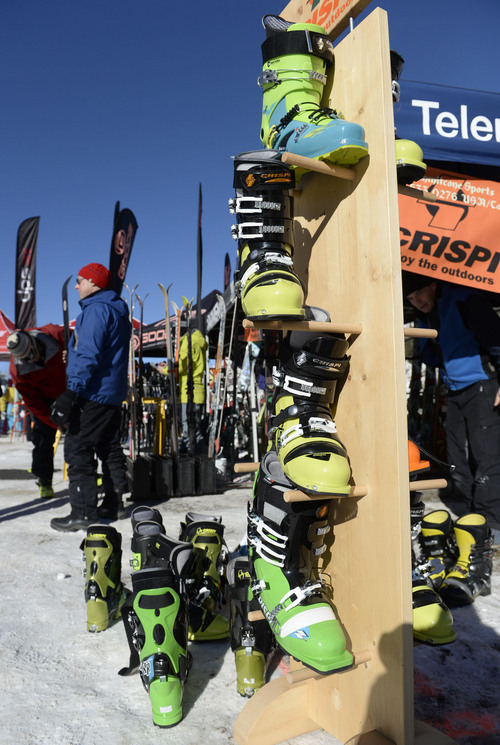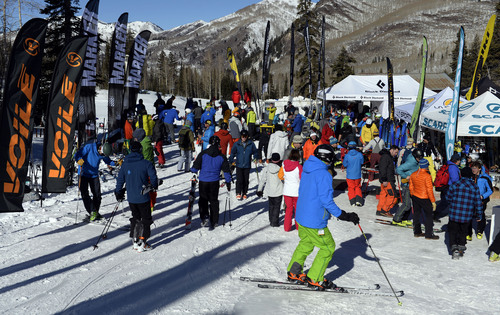This is an archived article that was published on sltrib.com in 2014, and information in the article may be outdated. It is provided only for personal research purposes and may not be reprinted.
There is a symbiotic relationship between conservation organizations trying to protect wild places and an outdoor gear industry that needs places where its customers can use its products.
That's why at every Outdoor Retailer show, it's possible to see a number of environmental nonprofit groups setting up booths in an effort to gain monetary or material support for their causes.
At the Winter Market show at the Salt Palace this week, which ended Saturday, booths along "nonprofit row" included such organizations as the Sierra Club, National Park Conservation Association, Leave No Trace, American Hiking Society, Splore, Boy Scouts of America and Big City Mountaineers.
"Clearly the outdoor industry has been a hub for us," said Craig Mackey, co-director of Protect the Flows, a Colorado-based organization that enlists businesses to conserve water in an effort to protect the Colorado River. "Places like the Colorado River are where their customers go to play. So the industry has a vested interest in protecting natural resources like the Colorado River and its tributaries."
Mackey worked three years as the director of government affairs for the Outdoor Industry Association, where he found manufacturers who were excited to be involved in environmental causes.
"It's a very green industry," he said. "It leads in sustainability as well. We have the industry coming to us and saying they want to lead on sustainability. There is a lot of sharing of best practices, and a lot off seeing what can be done in the value chain and supply chain to reduce everything from how the fabric is manufactured to how the product is shipped."
Protect the Flows is a coalition of 1,000 businesses that work to keep the Colorado River healthy and flowing during a time when the demand for water from the river currently exceeds supply. Mackey said that since 40 million people rely on the Colorado River for drinking water, it's a main source of water for 6 million acres of prime farmland, produces electricity and benefits recreation users and the companies that cater to them it makes sense for businesses to join his group.
His group tries to show companies that they can benefit financially by conserving Colorado River water by cutting costs, reducing waste, reducing operations' risks, increasing revenues by developing breakthrough products that are more water-efficient and enhancing brand value by building a positive corporate reputation.
"One of our messages came from an economic study on the river," said Mackey. "The river itself supports a $26 billion recreation economy just related to outdoor recreation and tourism. There are 230,000 direct jobs across seven basin states from Wyoming down to California."
He said the Bureau of Reclamation recently identified up to 3 million acre feet of water savings on the Colorado through conservation, which is the most cost-effective way to save the river as well. So his group is working with cities such as Las Vegas or major businesses such as MGM Resorts International on ways to conserve water.Another organization called 1% for the Planet was also represented at Outdoor Retailer. The group, which got its start in the outdoor industry, has expanded around the globe with 1,200 companies participating. According to Brodie O'Brien, the Vermont-based group's marketing manager, each of these companies contribute 1 percent of their sales to issues of sustainability with money going to nonprofits.
The organization acts as a consultant and certifier to show each of these companies are actually spending that money. Companies that sign up select their own nonprofits and give to them directly.
In Utah, there are nine companies that are members of 1% for the Planet and about 40 nonprofits including the Southern Utah Wilderness Alliance, Tread Lightly, Utah Open Lands, Save Our Canyons and Wasatch Community Gardens that have benefitted from donations.
"We have more than 3,000 nonprofit-approved recipient organizations eligible to receive funding from member companies," said Terry Kellogg, the 10-year-old organization's CEO.
O'Brien said that while 1% for the Planet was born in the outdoor industry, it has expanded to all sorts of different companies. Group members have donated $100 million over the last 10 years to support causes.
Protect the Flows and 1% for the Planet are just two of the many groups with either booths or who wander the floor of Outdoor Retailer to lobby for their causes, which often involve supporting underrepresented groups that use the outdoors or organizations and individuals who protect wild places.
Twitter: @tribtomwharton







